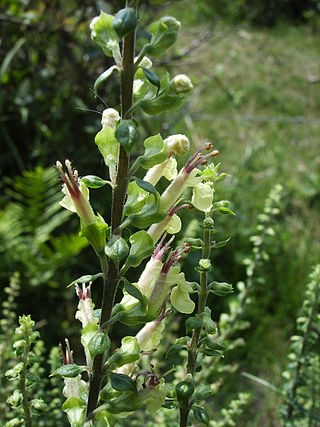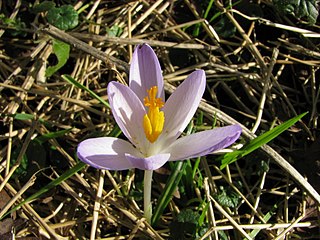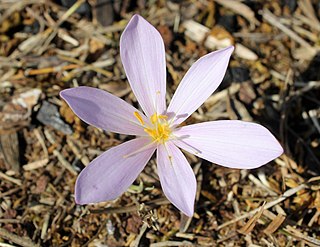
Teucrium scorodonia, common name the woodland germander or wood sage, is a species of flowering plant in the genus Teucrium of the family Lamiaceae. It is native to Western Europe and Tunisia, but cultivated in many places as an ornamental plant in gardens, and naturalized in several regions.

Agrostis nebulosa is a species of flowering plant in the family Poaceae. It is referred to by the common name cloud grass, and is an ornamental plant native to Morocco, Portugal and Spain. This plant is often cultivated for its light delicate heads that are used dried in floristry.

Helleborus cyclophyllus is a flowering perennial plant in the family Ranunculaceae. It is native to Albania, Bulgaria, Greece, and Yugoslavia. It is similar in appearance to other hellebores found in the Balkan region. It is acaulescent, meaning it lacks a stem with leaves, instead sending up a leafless flower stalk. The green leaves are palmate and basal, spreading at the ground. The flowers are green to yellow-green and 2 to 3 inches in diameter.

Senecio nevadensis is a species of flowering plant in the family Asteraceae.

Crocus tommasinianus, the woodland crocus, early crocus, or Tommasini's crocus, is a flower named after the botanist Muzio G. Spirito de Tommasini (1794-1879). It is native to Bulgaria, Hungary, Albania, and the former Yugoslavia. It is often referred to as the early or snow crocus, but these terms are shared with several other species, although C. tommasinianus is amongst the first to bloom. Multiple plants are often called tommies in the horticultural trade.

Salvia judaica is a species of flowering plant in the Lamiaceae family. It is a perennial commonly called Judean sage that is native to Mediterranean woodlands and shrublands, with violet flowers blooming from April–June.

Cyclamen africanum is a species of flowering plant in the family Primulaceae. It is referred to by the common name African cyclamen and is a perennial growing from a tuber, native to northern Algeria, Morocco and Tunisia. It is similar to Cyclamen hederifolium, but not frost-hardy.

Colchicum cilicicum, the Tenore autumn crocus, is a species of flowering plant in the Colchicaceae family. A bulbous perennial, it bears deep rose-lilac flowers in late summer, with barely any chequered pattern on the petals (tessellation). It has a very noticeable white stripe down the centre of each petal, which gives it a star-like appearance at the base. The flowers tend to stand up to weather better than other colchicum blooms. The flowers appear before the strap-like leaves, giving this and other colchicum species the common name “naked lady”. Although colchicums are called “autumn crocuses” they belong to a different family than true crocuses. There are in fact autumn-flowering species of crocus such as Crocus sativus, which is the source of the spice saffron. Colchicum cilicicum, by contrast, is toxic if eaten.

Colchicum micranthum is a species of flowering plant in the family Colchicaceae. It is native to Turkey with nearly white flowers barely 2 cm (.75") tall. It produces a series of blooms throughout the fall. The leaves follow the flowers, and are usually 3–5 in number.
Cotoneaster granatensis is a species of flowering plant in the family Rosaceae that can be found in Algeria, Morocco, Spain and Tunisia. It was described in 1836.

Papaver rupifragum is a species of flowering plant in the poppy family, Papaveraceae. It is native to Morocco and Spain.

Allium haemanthoides is a species of flowering plant in the Amaryllidaceae family. It is native to Iraq and Iran. It is a bulb-forming perennial with a densely packed umbel of white flowers with dark mideveins on the tepals.

Narcissus gaditanus is a species of the genus Narcissus (daffodils) in the family Amaryllidaceae. It is classified in Section Juncifolii, and is native to the southern Iberian Peninsula.

Crocus hyemalis is a species of flowering plant in the family Iridaceae. It is referred to by the common name winter saffron and is native to Lebanon-Syria and the Palestine region.

Armeria duriaei is a flowering plant in the family Plumbaginaceae. It is endemic to mountains of north-western Spain and adjacent regions of Portugal. Its flowers are usually pink, or rarely white.

Crocus ochroleucus is species of flowering plant in the Iridaceae family. It is a cream-colored crocus native to Lebanon, Palestine and Syria.
Erodium astragaloides is a species of flowering plant in the geranium family Geraniaceae. It is endemic to Sierra Nevada, southern Spain.

Crocus carpetanus is a species of flowering plant in the Iridaceae family. It is native to Portugal and Spain.
Crocus cyprius is a species of flowering plant in the genus Crocus of the family Iridaceae. It is a cormous perennial native to Cyprus where it is found in the Troödos Mountains.

Crocus haussknechtii is species of flowering plant growing from a corm native to southern Jordan, northern Iraq to western Iran.

















